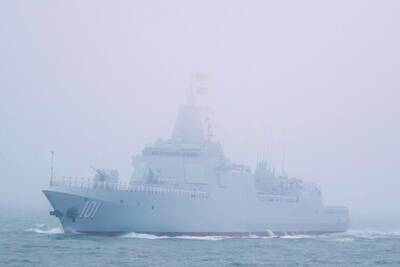As the third anniversary of the Asian tsunami nears, German scientists say they are working hard to honor a promise made to Indonesia to create an Indian Ocean alert system to prevent a repeat of the 2004 tragedy.
"The aim is to be able to send out an alert within 10 minutes of the earthquake that sets off the giant waves and to save lives," said Joern Lauterjung of Germany's national research center for geoscience (GFZ) in Potsdam outside Berlin.
The offer to develop a complex quake measuring system with sensors on land and the seabed relaying information via satellite to remote computers, was made three weeks after the tsunami killed some 220,000 people along the Indian Ocean shoreline on Dec. 26, 2004.
The government of Indonesia, which bore the brunt of the killer waves, immediately accepted and 120 German experts went to work on a project named the German Contribution to the Tsunami Early Warning System for the Indian Ocean (GITEWS).
Three years later, the mission is almost accomplished and the researchers hope to have the system up and running in November next year.
Since early 2005, the German team has worked with Indonesian, US and Japanese crews on setting up 160 seismic measuring stations on land and anchoring 23 sensors to the ocean bed.
The seabed sensors are vital to the system's success because the instruments on land cannot give scientists a picture of how the earth's plates have been deformed below the sea by a quake.
"The land sensors are not enough because they do not enable us to know how an earthquake has damaged the seabed. It is only if there is a vertical deformation that the seism will be followed by a tsunami," Lauterjung said.
In 2004, he explained, the strongest earthquake ever recorded in this region pushed the earth's crust upwards by 15cm with a violent jolt that triggered the tsunami.
The underwater sensors are cast into the waves attached to weights to make them sink more than 5km to the ocean floor.
They can measure the pressure of the water mass above them, and therefore its height. This means that any sudden variation in sea level is detected and used to predict the formation of giant waves.
The sensors carry out measurements every 15 seconds and relay the information to a buoy which sends the information to Jakarta via satellite.
If a quake is detected and at the same time the seabed monitors measure abnormal water pressure, another complex part of the warning system kicks in, as the GFZ's technology seeks to predict where and when the tsunami will strike the coast.
"These calculations unfortunately take a long time because, since the seabed is not even, the range of variables to be taken into account is vast. We have therefore developed models of potential trajectories to save our computers time," Lauterjung said.
The system had what his team described as a "baptism of fire" in September when an 8.4 magnitude earthquake struck off the west coast of Indonesia's Sumatra island. It measured the size and location of the event within a record five minutes.
This enabled the scientists at Potsdam to raise the alert to Indonesian authorities more than 10 minutes earlier than the Pacific Tsunami Warning Center in Hawaii.
It is big step forward in a field where mere minutes can mean the difference between life and death for people in the path of a tsunami, the GFZ's Joachim Zschau said.
It takes 10 minutes to 20 minutes from the time a seabed earthquake happens for a tsunami to hit the coast.
"The difference in time is really important because the challenge is to warn people away from the coastline within minutes," Zschau said. "If you have the information this soon after the earthquake hits, you could get the information to hotels and villages and avert a potential disaster."
Ultimately, the researchers said, common sense could prove as important in the rush to save lives as sophisticated technology.
"There are very simple things which we need to convey to the population in risk areas -- for example that shortly before the tsunami strikes, the ocean recedes, and that this is the moment to run," Lauterjung said.

ELECTION DISTRACTION? When attention shifted away from the fight against the militants to politics, losses and setbacks in the battlefield increased, an analyst said Recent clashes in Somalia’s semi-autonomous Jubaland region are alarming experts, exposing cracks in the country’s federal system and creating an opening for militant group al-Shabaab to gain ground. Following years of conflict, Somalia is a loose federation of five semi-autonomous member states — Puntland, Jubaland, Galmudug, Hirshabelle and South West — that maintain often fractious relations with the central government in the capital, Mogadishu. However, ahead of elections next year, Somalia has sought to assert control over its member states, which security analysts said has created gaps for al-Shabaab infiltration. Last week, two Somalian soldiers were killed in clashes between pro-government forces and

Ten cheetah cubs held in captivity since birth and destined for international wildlife trade markets have been rescued in Somaliland, a breakaway region of Somalia. They were all in stable condition despite all of them having been undernourished and limping due to being tied in captivity for months, said Laurie Marker, founder of the Cheetah Conservation Fund, which is caring for the cubs. One eight-month-old cub was unable to walk after been tied up for six months, while a five-month-old was “very malnourished [a bag of bones], with sores all over her body and full of botfly maggots which are under the

BRUSHED OFF: An ambassador to Australia previously said that Beijing does not see a reason to apologize for its naval exercises and military maneuvers in international areas China set off alarm bells in New Zealand when it dispatched powerful warships on unprecedented missions in the South Pacific without explanation, military documents showed. Beijing has spent years expanding its reach in the southern Pacific Ocean, courting island nations with new hospitals, freshly paved roads and generous offers of climate aid. However, these diplomatic efforts have increasingly been accompanied by more overt displays of military power. Three Chinese warships sailed the Tasman Sea between Australia and New Zealand in February, the first time such a task group had been sighted in those waters. “We have never seen vessels with this capability

‘NO INTEGRITY’: The chief judge expressed concern over how the sentence would be perceived given that military detention is believed to be easier than civilian prison A military court yesterday sentenced a New Zealand soldier to two years’ detention for attempting to spy for a foreign power. The soldier, whose name has been suppressed, admitted to attempted espionage, accessing a computer system for a dishonest purpose and knowingly possessing an objectionable publication. He was ordered into military detention at Burnham Military Camp near Christchurch and would be dismissed from the New Zealand Defence Force at the end of his sentence. His admission and its acceptance by the court marked the first spying conviction in New Zealand’s history. The soldier would be paid at half his previous rate until his dismissal